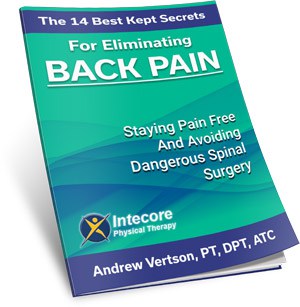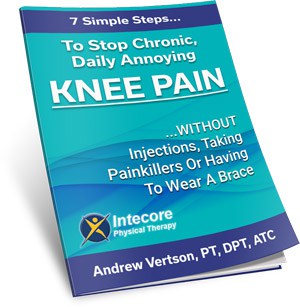As we embrace fitness goals, home projects, or even intense gardening, the excitement of getting active can sometimes overshadow one critical step: preparing your back. I’ve encountered countless cases at our clinics where a lack of preparation—not just poor technique—has led to unnecessary strains and discomfort.
Whether you’re hitting the gym, training for a marathon, or simply tackling a heavy weekend chore, your back is the central pillar. That’s why I’m sharing 3 essential back-saving principles to ensure you are equipped with the knowledge to approach any physical activity safely and pain-free.
More Posts Like This From Intecore:
Is Exercising Making My Hip Pain Worse?
How To Reduce The Risk Of An Injury
FAQs About Back Pain Answered
The Importance of Protecting Your Back Before Exercise
Engaging in physical activity—from lifting weights to simple bending and twisting—is a fantastic way to stay healthy. However, it’s crucial to approach these tasks with an awareness of the potential stress they can exert on your spine, muscles, and ligaments.
Understanding The Risks
An unprepared or “cold” back is highly vulnerable. Overexertion, improper lifting, or sudden, explosive movements without proper warm-up can lead to:
Acute Pain or Muscle Spasms: Often caused by a sudden strain on cold, stiff muscle fibers.
Chronic Issues: Repetitive stress without adequate recovery can lead to long-term disc or joint problems.
Muscle Imbalances: Favoring one side during a repetitive movement (like swinging a golf club or shoveling) can lead to asymmetrical strain, particularly affecting the lower back.
The first step in preventing injury is understanding that preparation is non-negotiable. In the upcoming sections, we’ll explore practical tips to help you safeguard your body while taking part in any activity.
Principle 1: Warm-Up and Dynamic Stretching
Before you put any load on your body, you must prepare the engine. Ensuring your muscles are warm and your joints are mobilized can significantly reduce the risk of strains and injuries.
Gentle Warm-Up Routine
Start with a gentle 5-10 minute warm-up to increase blood flow and raise your core body temperature. This should be light, aerobic activity, not strenuous.
Aerobic Start: A brisk walk, light jogging in place, or pedaling on a stationary bike.
Upper Body Mobility: 5 minutes of movements like shoulder rolls, arm circles, and gentle neck rotations to loosen the shoulders and upper back.
Lower Body Mobility: Ankle rolls, gentle knee bends (half squats), and hip circles to prepare the legs and hips, which support the lower back.
Effective Stretches for the Back (Dynamic)
Once you’re warm, focus on dynamic stretches—stretches that involve movement—to actively prepare the muscles you’ll be using.
Cat-Cow Stretch: On hands and knees, arch your back up (Cow), then dip your back down (Cat). This is a fantastic dynamic stretch for the entire spine.
Torso Twists (Standing): Standing with feet shoulder-width apart, gently rotate your torso side-to-side, letting your arms swing loosely. This loosens the mid and upper back safely.
Arm and Leg Swings: Lightly swing your legs front-to-back and side-to-side to prepare the hips, which are directly connected to lower back stability.
Crucial Note: Dynamic stretching is best before exercise. Save static (held) stretches for after your workout.
Principle 2: Proper Body Mechanics and Posture
The way you move dictates the force placed on your spine. Mastering proper mechanics minimizes unnecessary strain, whether you’re lifting a box or a barbell.
Stance and Posture – Maintain a stance that is stable and flexible during any activity:
Feet: Keep your feet shoulder-width apart for a balanced base.
Knees: Keep your knees slightly bent (“soft knees”) and avoid locking them out, which protects both the knees and the lower back.
Core Engagement: Before any major effort (lifting, pushing, pulling), gently brace your core. This acts as a natural corset, stabilizing your spine.
Techniques to Minimize Strain
Lift with Your Legs, NOT Your Back: When picking anything up (from a pen to a kettlebell), bend at your hips and knees, keeping your back as straight as possible. Your legs should do the work.
Minimize Twisting: Never combine bending forward and twisting. If you need to turn while holding an object, pivot your entire body (feet first) rather than twisting your waist.
Balance the Load: When carrying items, try to distribute the weight evenly. If using repetitive movements (like carrying groceries or swinging a shovel), switch your leading hand or side periodically to balance the workload.
Principle 3: Listen to Your Body, Rest, and Recover
The best prevention tool is the awareness of your own body. Taking adequate rest is crucial for preventing overexertion and injury, allowing the muscles to recuperate and strengthen.
Signs of Overexertion and Injury
Being attuned to your body’s signals is key. If you experience any of the following, it’s crucial to stop and rest:
Sharp, shooting, or stabbing pain (especially in the back).
Numbness or tingling in the legs or feet.
Sudden, unexpected muscle cramps.
Excessive fatigue or dizziness.
Self-Care for a Healthy Back
Post-activity self-care is just as important as the warm-up:
Recovery: Give your body time to rebuild. If you did an intense workout one day, dedicate the next day to light movement or full rest.
Thermotherapy: If you feel stiff, consider applying a warm compress to relax the muscles. If you notice localized inflammation or swelling, an ice pack can be effective.
Gentle Static Stretches: After your muscles are fully cooled down, holding stretches like the Child’s Pose or knees-to-chest stretch can aid in recovery and flexibility.
Remember to listen to your body. If back discomfort persists for more than a couple of days, or if the pain is severe, seeking professional help is advised.
Ready to Experience the Benefits of Physical Therapy?
Our physical therapists are equipped with the skills and knowledge to alleviate pain, offer tailored exercises based on your activity level, and provide guidance on preventing future strains. We don’t just treat injuries; we help you build a stronger foundation for a pain-free, active life.
How does this expanded, evergreen version look? It should generate much broader interest and relevance for your audience!
- 3 Essential Back-Saving Tips You MUST Know Before Any Workout - November 14, 2025
- Dormant Butt Syndrome: How to Wake Up Your Glutes - August 13, 2025
- Your Comprehensive Guide to Understanding and Managing Pain with Physical Therapy - June 11, 2025













